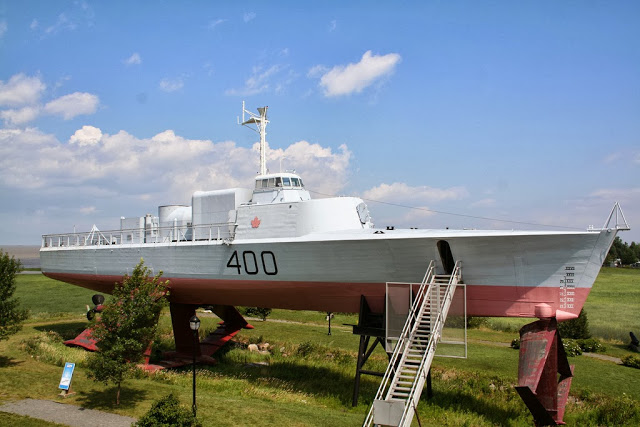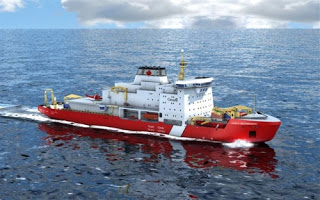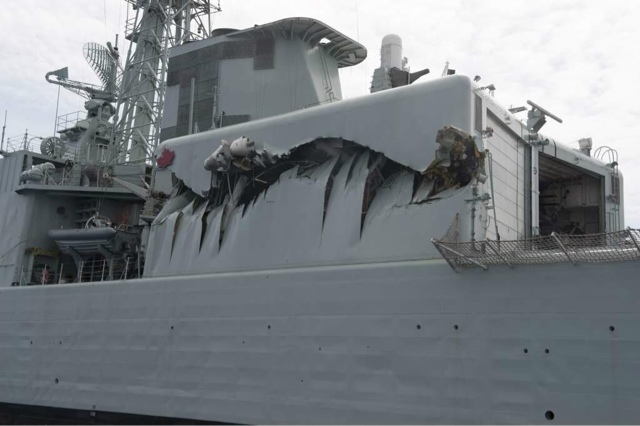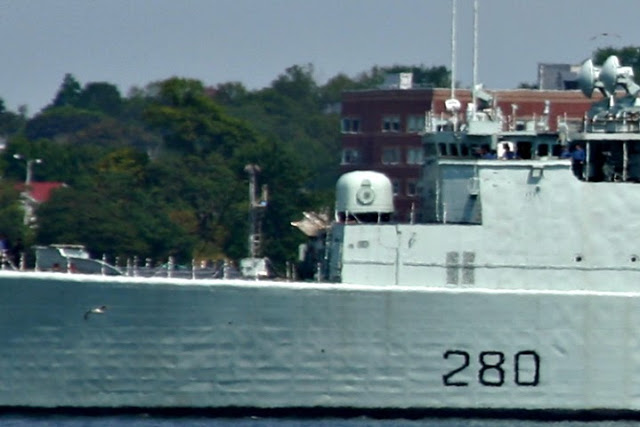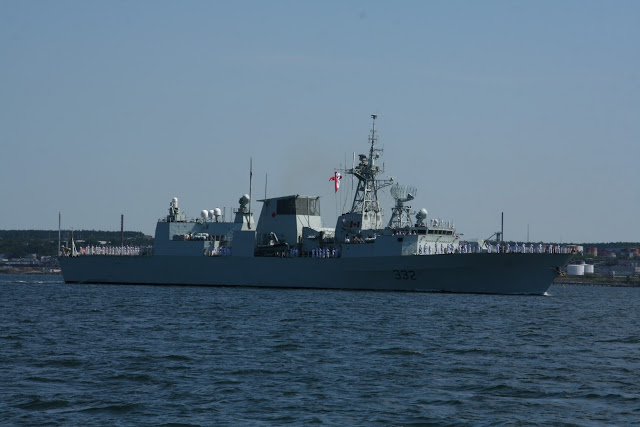HMCS Ville De Quebec, and HMCS Iroquois returned this morning from Op Caribbe, An annual anti narcotics operation with the USN and USCG. Ville De Quebec Departed on July 22
Category Archives: Navy
HMCS Halifax
HMCS Halifax Spent the weekend secured to 4 mooring trot buoys in the North end of the Basin this weekend, Likely undergoing system and sensor tests. The Fleet Diving Unit appeared to be in Attendance, and a barge is alongside acting as a wharf for smaller vessels.
She Departed this morning for sea.
HMCS Fredricton Post FELEX Trials
HMCS Bras D’or (FHE 400)
HMCS Bras d’Or (FHE 400) was a hydrofoil that served in the Canadian Forces from 1968 to 1971. During sea trials in 1969, the vessel exceeded 63 knots (117 km/h; 72 mph), making her the fastest warship in the world.
The vessel was built from 1960 to 1967 for the Royal Canadian Navy, as a project for the testing of anti-submarine warfare technology on an ocean-going hydrofoil. Changes in priorities and cost overruns later led to the project’s cancellation. HMCS Bras d’Or (FHE 400) was the second vessel to bear that name (see below) and was built at Marine Industries Limited (MIL) in Sorel, Quebec, the primary contractor being de Havilland Canada, an aircraft company
The ship was saved and donated to the Musée Maritime du Québec at L’Islet-sur-Mer, Quebec. Bellow are photos from my visit in 2006.
For Additional Photos Of her running, See this Link
Replacing Preserver and Protectur – Part 2.
For Part one, See Replacing Preserver and Protector
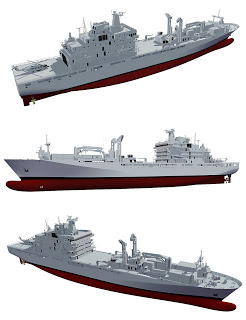 In part one We looked at the the Joint Support Ship, and how we went from replacing AOR’s (Fleet Replenishment Oilers) to a command and control + AOR. And how that requirement evolved and de-volved bring us back to a more traditional AOR Design.On June 2 2012, The Government announced we would be building 2 of the Berlin Class, already in use by the German Navy, And we know from the NSPS process that Sea Span will be building the vessels.
In part one We looked at the the Joint Support Ship, and how we went from replacing AOR’s (Fleet Replenishment Oilers) to a command and control + AOR. And how that requirement evolved and de-volved bring us back to a more traditional AOR Design.On June 2 2012, The Government announced we would be building 2 of the Berlin Class, already in use by the German Navy, And we know from the NSPS process that Sea Span will be building the vessels.
Great – So now we know what were building, and who is going to do it. Not so fast, this is a government Procurement – it cant be that simple, and it isn’t. Seaspan is tied up, they also won the right to build the Coast Guards new Polar Icebreaker, the CCGS John Diefenbaker, the government must now decide who gets their aging ships replaced first, as Both the CCGS Louis St. Laurent and Preserver and Protector are well past their prime. All three vessels were commissioned in 1969/70 so they are all of the same vintage, and all have had major work done recently to keep them operating.
So who waits?
It would seem that building the heavy ice breaker first would make the most sense. Once steel cutting is done on it, and fabrication is well underway, then fabrication can begin on the 2 new AOR’s. it would be a longer wait for the the Icebreaker would the AOR’s go first, and worst case, we can borrow/make use of our Allies replenishment capability. The Americans heavy icebreaker program is in equally bad shape.
So when will they be replaced? Who knows. but we know what we are getting.
Incidentally, based on a briefing note it looks like the first NSPS Vessels will be the Offshore Fisheries research Vessels to be built by SeaSpan. the Build start is scheduled for 2014 with delivery in 2015.
2 Canadian warships colide
Her Majesty’s Canadian Ship (HMCS) Algonquin and HMCS Protecteur are expected to return to Esquimalt harbour at 4:00 p.m. Saturday following a collision with one another yesterday at approximately 11 a.m. PST while conducting exercise maneuvers en route to Hawaii. There were no reported injuries.
“The Royal Canadian Navy will be conducting an investigation into this unfortunate incident in order to determine exactly what happened,” said Commodore Bob Auchterlonie, Commander of Canadian Fleet Pacific.
The two warships were conducting towing exercises, which require close-quarters maneuvering, when the incident occurred.
HMCS Algonquin sustained significant damage to her hangar on her port side while HMCS Protecteur sustained damage of a lesser degree to her bow. While the full impact on the ships’ future sailing schedules has yet to be determined, HMCS Algonquin will no longer deploy to Asia Pacific region as planned.
A Board of Inquiry will be convened to further investigate the incident and circumstances surrounding it, and will make recommendations as to how to prevent a similar event from occurring in the future. More information about the incident itself will be released when available.
HMCS Iroquois – RAS Excercise?
A reader sent me the above photo of HMCS Iroquois departing the harbor at a very high rate of speed this morning. (Just look at the wake) I have no idea what was up, how ever she appeared to be circling in the outer anchorages.

HMCS Summerside to deploy to Arctic
HMCS Summerside departed today from Halifax, N.S. for Canada’s arctic, where she will be joined later in August by HMCS Shawinigan. This deployment is a part of a 39-day mission north of the 60th parallel, marking the Royal Canadian Navy’s (RCN) longest uninterrupted arctic naval presence in recent years.
During the deployment, HMCS Summerside and HMCS Shawiniganwill participate in Operations QIMMIQ and NANOOK, conducting surveillance and presence activities, as well as joint training scenarios, showcasing Canadian Armed Forces assistance to civil emergency management and law enforcement agencies during threats to public safety.
Operation NANOOK, the most widely recognized of all the northern deployments, and Operation QIMMIQ, a year-round persistent surveillance and presence operation, are directed by Canadian Joint Operations Command. Other yearly Northern deployments include the springtime Operation NUNALIVUT in the high Arctic and the summertime Operation NUNAKPUT in the western Arctic .
“The deployment of maritime coastal defence vessels in Canada’s northern waters serves as an example of how our Navy demonstrates sovereignty in the North and, when authorized, assist other government departments in enforcing national and international law,”
said Vice Admiral Mark Norman, Commander of the RCN. “The experience will also help us prepare the stage for more extensive operations in the ice, to be conducted in the future by our Arctic and Offshore Patrol Ships, by ironing out some of the logistical and operating challenges generated by the sheer distances, remoteness, and generally harsher environmental conditions in the North.”
Ville De Quebec Sails For Op Caribbe
Her Majesty’s Canadian Ship (HMCS) Ville de Quebec departed Halifax today on Operation Caribbe, Canada’s continuing commitment to the multinational effort to suppress illicit narcotics trafficking in the Caribbean Sea.
During the deployment, the Halifax-class frigate and her crew of approximately 220 personnel will work with the U.S. Navy, the U.S. Coast Guard and other regional partners to locate and track vessels of interest.
The trafficking of illicit narcotics is a significant source of revenue for organized crime and a growing threat to global security. Operation Caribbe is one of the many activities that the Government of Canada and the Canadian Armed Forces (CAF) undertake as part of Canada’s broad focus and ongoing engagement in the Americas and the Caribbean.
This annual operation directly supports the CAF’s mission to defend against threats and security challenges to Canada and North America. The CAF has deployed a periodic rotation of warships as well as CP-140 Aurora aircraft from both East and West Coasts since 2006 to ensure continuous support to this operation.



